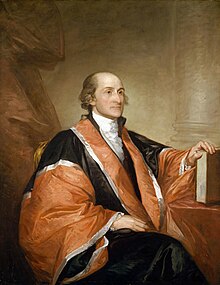John Jay
John Jay | |
|---|---|
 | |
| 1st Chief Justice of the United States | |
| In office September 26, 1789 – June 29, 1795 | |
| Nominated by | George Washington |
| Preceded by | Office established |
| Succeeded by | John Rutledge |
| 2nd Governor of New York | |
| In office July 1, 1795 – June 30, 1801 | |
| Lieutenant | Stephen Van Rensselaer |
| Preceded by | George Clinton |
| Succeeded by | George Clinton |
| Acting United States Secretary of State | |
| In office September 15, 1789 – March 22, 1790 | |
| President | George Washington |
| Preceded by | Himself as Secretary of Foreign Affairs |
| Succeeded by | Thomas Jefferson |
| United States Secretary of Foreign Affairs | |
| In office July 27, 1789 – September 15, 1789 Acting | |
| President | George Washington |
| Preceded by | Himself |
| Succeeded by | Himself as Secretary of State |
| In office May 7, 1784 – March 4, 1789 | |
| Appointed by | Confederation Congress |
| Preceded by | Robert Livingston |
| Succeeded by | Himself (acting) |
| United States Minister to Spain | |
| In office September 27, 1779 – May 20, 1782 | |
| Appointed by | Second Continental Congress |
| Preceded by | Office established |
| Succeeded by | William Carmichael |
| 6th President of the Second Continental Congress | |
| In office December 10, 1778 – September 28, 1779 | |
| Preceded by | Henry Laurens |
| Succeeded by | Samuel Huntington |
| Delegate to the Second Continental Congress from New York | |
| In office December 7, 1778 – September 28, 1779 | |
| Preceded by | Philip Livingston |
| Succeeded by | Robert Livingston |
| In office May 10, 1775 – May 22, 1776 | |
| Preceded by | Seat established |
| Succeeded by | Seat abolished |
| Delegate to the First Continental Congress from Province of New York | |
| In office September 5, 1774 – October 26, 1774 | |
| Preceded by | Seat established |
| Succeeded by | Seat abolished |
| Personal details | |
| Born | December 23, 1745 New York City, New York, British America |
| Died | May 17, 1829 (aged 83) Bedford, New York, U.S. |
| Political party | Federalist |
| Spouse(s) | Sarah Livingston |
| Children | 6, including Peter and William |
| Education | Columbia University (BA, MA) |
| Signature | |
John Jay (December 23, 1745 – May 17, 1829) was an American politician, statesman, slave owner, and diplomat.[1] He was a Supreme Court Chief Justice and one of the Founding Fathers of the United States. Jay served in the Continental Congress and was elected President of that body. During and after the American Revolution, he was a minister (ambassador) to Spain and France, helping to fashion American foreign policy and to secure favorable peace terms from the British and French. He co-wrote the Federalist Papers with Alexander Hamilton and James Madison.
Jay served on the U.S. Supreme Court as the first Chief Justice of the United States from 1789 to 1795. In 1794 he negotiated the Jay Treaty with the British. A leader of the new Federalist party, Jay was governor of New York from 1795 to 1801. He was the leading opponent of slavery and the slave trade in New York. His first attempt to pass emancipation legislation failed in 1777 and failed again in 1785, but he succeeded in 1799, signing the law that eventually emancipated the slaves of New York; the last were freed before his death.
References[change | change source]
- ↑ Benton, Ned; Peters, Judy Lynne. "Slavery and the Extended Family of John Jay". New York Slavery Records Index. Retrieved 2020-11-16.

